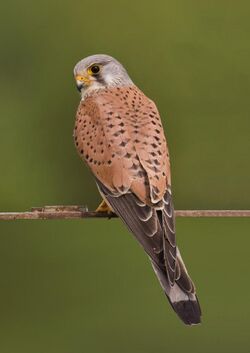Biology:Eufalconimorphae
From HandWiki
Short description: Proposed clade of birds
| Eufalconimorphae | |
|---|---|

| |
| Common kestrel, Falco tinnunculus | |
| Scientific classification | |
| Domain: | Eukaryota |
| Kingdom: | Animalia |
| Phylum: | Chordata |
| Class: | Aves |
| Clade: | Australaves |
| Clade: | Eufalconimorphae Suh et al., 2011 |
| Subclades | |
Eufalconimorphae is a proposed clade of birds, consisting of passerines, parrots, falcons, caracaras, and forest falcons (but not other raptors).[3] It has whole-genome DNA support.[4] Eufalconimorphae birds are characterized by their strong and hooked beaks, sharp talons, and powerful wings. They have excellent eyesight, which allows them to spot their prey from great distances. The Eufalconimorphae is noted to produce aerodynamic force during the upstroke of flight to help create a vertical flight pattern.[5]
See below cladogram showing Eufalconimorphae's relationship within Australaves:[4][6]
| Australaves |
| ||||||||||||||||||
References
- ↑ Boles, Walter E. (1997). "Fossil songbirds (Passeriformes) from the Early Eocene of Australia". Emu 97 (1): 43–50. doi:10.1071/MU97004. Bibcode: 1997EmuAO..97...43B.
- ↑ Kuhl., H.; Frankl-Vilches, C.; Bakker, A.; Mayr, G.; Nikolaus, G.; Boerno, S. T.; Klages, S.; Timmermann, B. et al. (2020). "An unbiased molecular approach using 3'UTRs resolves the avian family-level tree of life.". Molecular Biology and Evolution 38: 108–127. doi:10.1093/molbev/msaa191. PMID 32781465.
- ↑ Alexander Suh; Martin Paus; Martin Kiefmann; Gennady Churakov; Franziska Anni Franke; Jürgen Brosius; Jan Ole Kriegs; Jürgen Schmitz (2011). "Mesozoic retroposons reveal parrots as the closest living relatives of passerine birds". Nature Communications 2 (8): 443. doi:10.1038/ncomms1448. PMID 21863010. Bibcode: 2011NatCo...2..443S.
- ↑ 4.0 4.1 Jarvis, E. D.; Mirarab, S.; Aberer, A. J.; Li, B.; Houde, P.; Li, C.; Ho, S. Y. W.; Faircloth, B. C. et al. (2014). "Whole-genome analyses resolve early branches in the tree of life of modern birds". Science 346 (6215): 1320–1331. doi:10.1126/science.1253451. PMID 25504713. PMC 4405904. Bibcode: 2014Sci...346.1320J. https://pgl.soe.ucsc.edu/jarvis14.pdf. Retrieved 2015-08-29.
- ↑ Razmadze, Daria; Panyutina, Aleksandra A.; Zelenkov, Nikita V. (October 2018). "Anatomy of the forelimb musculature and ligaments of Psittacus erithacus (Aves: Psittaciformes)" (in en). Journal of Anatomy 233 (4): 496–530. doi:10.1111/joa.12861. PMID 30033585.
- ↑ "An unbiased molecular approach using 3'UTRs resolves the avian family-level tree of life". Molecular Biology and Evolution 38 (1): 108–127. January 2021. doi:10.1093/molbev/msaa191. PMID 32781465.
External links
- Tetrapod Zoology, after Suh et al. (2011).
Wikidata ☰ Q326483 entry
 |


